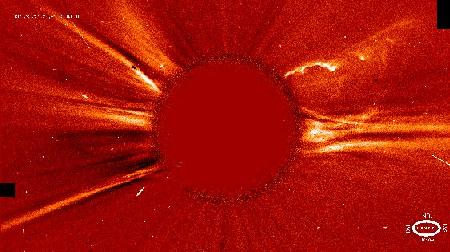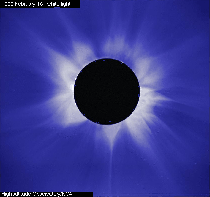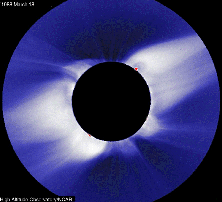 |
| The solar corona |
| The Solar Corona |
 |
| The solar corona |
The extended outer atmosphere of the Sun is called the corona. It has a temperature of millions of degrees, but it is 10 billion times less dense than the atmosphere of the Earth at sea level.
 |
| Solar corona viewed using a coronagraph (more info) |
These two images, taken using the coronameter of the Mauna Loa Solar Observatory, shows the corona 27 days apart (approximately one solar rotation).
As we shall discuss further in the section on the solar wind, the coronal holes are regions where the magnetic field lines of the Sun are open, allowing coronal gas to flow outward into space and producing the solar wind. In contrast, the capped looking streamers in the corona (helmet streamers) correspond to regions in which the magnetic field lines are closed in a loop, trapping the coronal gas and leading to enhanced X-ray emission because of the increased gas densities.
 |
| The sun through a coronagraph (more info) |
The preceding image (in false color) was taken with the Large Angle and Spectrometric Coronagraph on board the SOlar and Heliospheric Observatory (SOHO). It shows rather graphically the streamers in the solar corona.
 |
 |
| The solar corona during the 1980 solar eclipse (left) and 1988 solar eclipse (right). The 1980 eclipse was near a solar activity maximum and the 1988 eclipse was near a minimum (Source) | |
The left image was obtained during a period of high solar activity and the right during a period of relatively low solar activity. Notice the fundamentally different appearance of the corona. The corona during the active Sun period shows many streamers at all angles around the disk of the Sun, while the corona during the quiet Sun period shows larger bottle-shaped streamers (the helmet streamers mentioned earlier) concentrated in latitudes near the equator.
You may monitor the current appearance of the Solar corona with this link to the Mauna Loa Coronameter